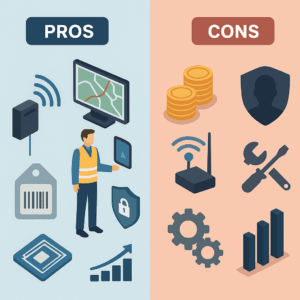For businesses wanting to remain productive while minimizing losses, asset tracking is essential. Radio Frequency Identification (RFID) technology has become a prominent solution to track, monitor, and control assets across various industries.
In this post, we cover both the advantages and disadvantages of asset tracking RFID software to help you determine if you should implement RFID technology in your organization. Understanding these factors will help you make an informed decision about whether this investment aligns with your operational needs.
Pros of RFID Asset Tracking
Enhanced Accuracy
Asset tracking via RFID technology is super precise compared to traditional methods. RFID eliminates human error, unlike manual processes, which leads to more accurate data collection and reporting. This improved accuracy ultimately results in better decisions and improved overall operational performance.
Real-Time Monitoring
RFID provides real-time updates, which is one of the most appealing features for modern businesses. It offers continuous monitoring capabilities, providing instant location and status information for assets. This is important in sectors or industries where the availability of assets is time-critical, such as healthcare or manufacturing.
Automated Operations
RFID is a great way to automate tracking processes that were previously manual. Automating asset tracking saves time and resources for businesses across all departments. The automation will free employees to tackle higher-level work, improving productivity across departments.
Improved Security
The use of RFID improves security with a detailed history of record keeping for asset movement. It helps quickly detect unauthorized access or loss of assets and enables immediate action to be taken. This capability helps secure valuable resources from theft or misplacement.
Scalability
RFID systems have the capacity to grow with your business over time. RFID technology can easily adjust to different scales, whether you are monitoring a handful of items or hundreds of thousands of assets.
Challenges of RFID-Based Asset Tracking
Initial Costs
An RFID setup requires a considerable capital investment for most organizations. Buying tags, readers, and software comes at a high price point. These initial costs can be a deterrent to adoption for smaller businesses with limited budgets.
Infrastructure Requirements
Deploying RFID requires utilizing certain infrastructure, including antennas and readers throughout the facility. Installing this setup might require modifications to current facilities, incurring extra costs and leading to interruptions during the installation process.
Interference Issues
RFID systems can experience interference from metal objects or electronic devices in the environment. This interference can affect the quality of the signal itself, which in turn makes the information from the receiver unreliable. To overcome these challenges, businesses may have to purchase specialized equipment.
Privacy Concerns
The use of RFID technology has raised privacy concerns among employees and customers. Because assets are being tracked constantly, data can easily be misused if proper safeguards are not in place. According to Federal Trade Commission guidelines, organizations should implement appropriate measures to protect sensitive tracking data.
Maintenance and Updates
As with any technology, RFID systems need periodic maintenance and software upgrades. Meeting these ongoing requirements can require resources, in both time and money. These maintenance needs repeat regularly, and businesses must prepare for these recurring expenses.
Factors for RFID Implementation
Assess Business Needs
It is crucial to identify particular business needs beforehand to understand how RFID will adapt to your operations. The type of RFID solution to use depends on the scale of operations and types of assets involved.
Cost-Benefit Analysis
An extensive cost-benefit assessment can provide valuable insights into the possible return on investment. A thorough cost-benefit analysis highlights the true value of RFID when viewed over the long term rather than just initial expenses.
Vendor Selection
Selecting the correct vendor is necessary for the successful implementation of RFID technology. Businesses will benefit from choosing vendors with a proven track record and ongoing customer support, which will help make the transition smoother and more successful.
Training and Support
To implement RFID technology successfully, businesses must train employees to use the system properly. Staff will be able to maximize the technology’s potential with proper training and ongoing support from vendors and internal IT teams.
Monitoring and Evaluation
It is necessary to regularly inspect and assess the RFID system’s performance. System performance evaluation and adjustments help ensure that technology continues to serve the business needs effectively over time.
Conclusion
RFID-based asset tracking has enormous benefits, ranging from accuracy improvements to enhanced security capabilities. Although it does have some challenges, like startup costs and potential interference issues, the long-term benefits often outweigh these initial hurdles. Companies need to identify their requirements, weigh the costs against the benefits, and choose an appropriate vendor for implementation. While RFID will help improve asset management processes, careful planning is required to get the best results from the technology. Companies that weigh both the pros and cons can make informed decisions that align with their operational goals.





Leave a Reply